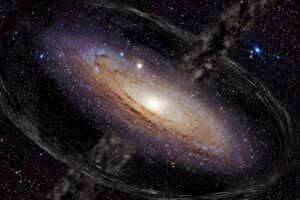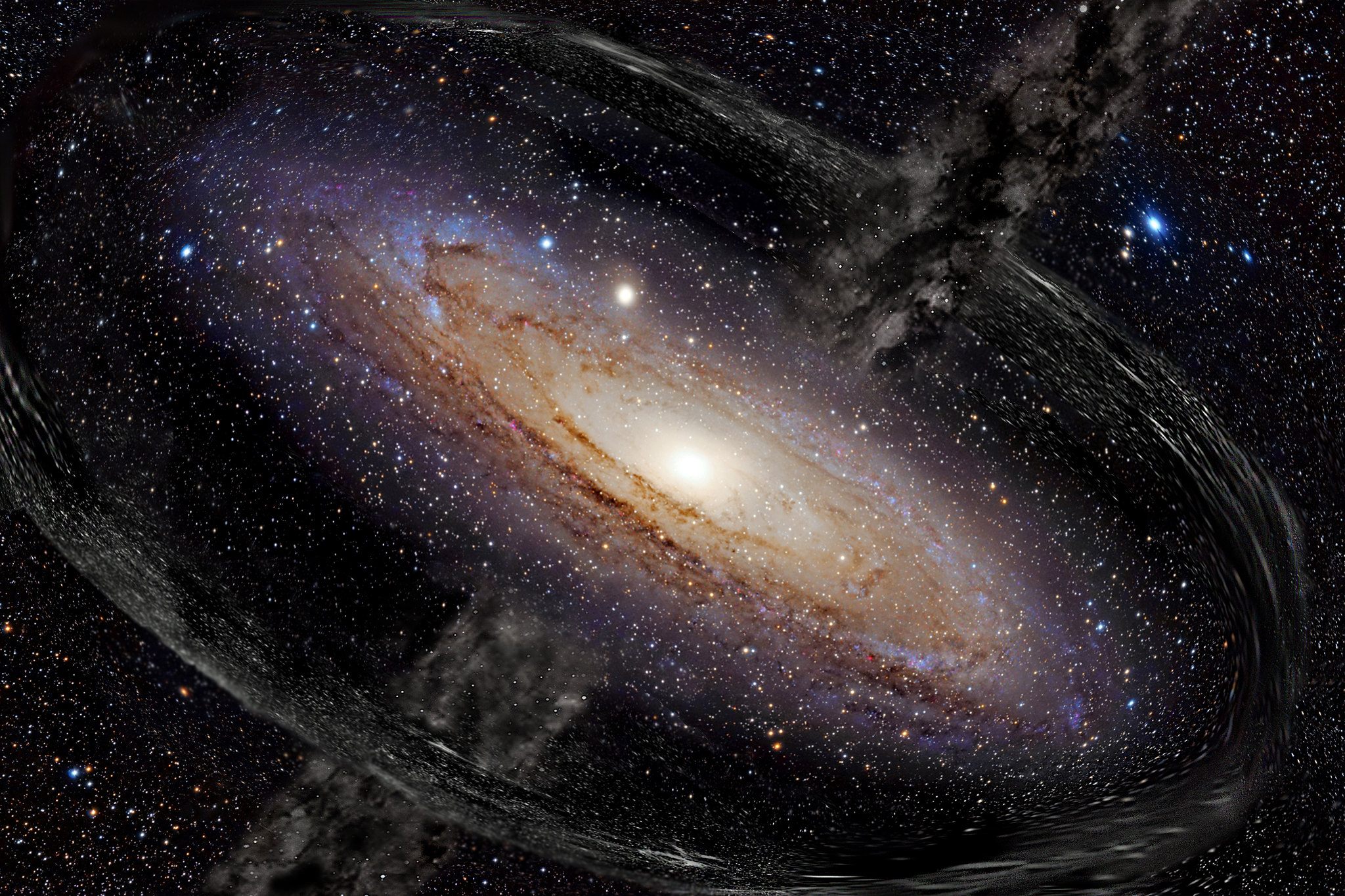The Mysteries of Dark Matter and Dark Energy: Unraveling the Universe’s Greatest Enigmas
In the vast expanse of the cosmos, two enigmatic entities dominate the cosmic ballet: dark matter and dark energy. Despite comprising the vast majority of the universe’s content, both remain invisible and elusive, challenging our fundamental understanding of the cosmos. This article delves into the current theories, ongoing research, and efforts to uncover the secrets of these mysterious components.

(flickr.com)
Dark Matter: The Invisible Architect
Dark matter serves as the unseen scaffolding upon which galaxies are built, constituting approximately 27% of the universe’s total mass-energy content. Unlike ordinary matter, dark matter neither emits nor absorbs light, rendering its detection challenging yet crucial for understanding the dynamics of galaxies and the formation of large-scale cosmic structures.
The presence of dark matter first became apparent through its gravitational effects on visible matter. Observations of galactic rotation curves revealed that galaxies spin faster than expected based on the visible stars and gas alone. This discrepancy suggests the existence of additional mass, distributed more widely than the visible components, exerting gravitational influence on the stars and gas within galaxies.
In addition to galactic rotation curves, gravitational lensing provides further evidence for dark matter. This phenomenon occurs when the gravitational field of dark matter bends the path of light from distant objects, distorting our view of the cosmos. Furthermore, measurements of the cosmic microwave background radiation, the afterglow of the Big Bang, indicate that dark matter contributes significantly to the overall structure and evolution of the universe.
The search for dark matter particles has led to the exploration of various theoretical candidates. Among these are Weakly Interacting Massive Particles (WIMPs), hypothesized to interact with ordinary matter through weak nuclear force, and Massive Compact Halo Objects (MACHOs), which could include dim stars, black holes, or other compact astronomical objects that emit little or no light. Another candidate is axions, hypothetical particles with properties that could explain certain fundamental aspects of particle physics.
Experimental efforts to detect dark matter focus on both direct and indirect methods. Direct detection experiments use sensitive detectors located deep underground to shield them from cosmic rays and other background radiation that could interfere with measurements. Examples include the XENON, LUX-ZEPLIN (LZ), and DAMIC experiments, which aim to capture rare interactions between dark matter particles and ordinary matter. Indirect detection methods involve observing secondary signals such as cosmic rays or gamma rays produced when dark matter particles annihilate or decay in space, as detected by instruments like gamma-ray telescopes.
Advancements in both theoretical models and experimental techniques continue to push the boundaries of our understanding of dark matter. These efforts not only seek to confirm its existence and properties but also aim to illuminate its role in the cosmic web of galaxies and the evolution of the universe on the largest scales.
Dark Energy: The Force Behind Cosmic Acceleration
Dark energy stands in stark contrast to dark matter, as it drives the accelerated expansion of the universe rather than binding galaxies together. Discovered in the late 1990s through observations of distant Type Ia supernovae, dark energy comprises approximately 68% of the universe’s total energy density. Its presence fundamentally challenges traditional cosmological models, which initially predicted a universe that should be slowing down in its expansion due to gravitational attraction.
The nature of dark energy remains one of the most profound mysteries in modern cosmology. The leading hypothesis to explain dark energy is a cosmological constant, denoted by the Greek letter lambda (Λ), which represents a constant energy density filling the entirety of space uniformly. This idea, initially proposed by Albert Einstein in his general theory of relativity, suggests that dark energy exerts a repulsive force that counteracts gravity’s attractive pull on cosmic scales.
Alternative theories of dark energy propose dynamical entities known as quintessence. Unlike a cosmological constant, quintessence involves a scalar field that varies over both space and time. This dynamical nature could explain how dark energy’s influence might evolve across cosmic epochs, potentially offering insights into discrepancies observed in the cosmic microwave background and large-scale structure of the universe.
Observational evidence for dark energy comes from various sources. Measurements of the cosmic microwave background radiation, the afterglow of the Big Bang, provide a snapshot of the universe’s early conditions and the imprint of dark energy’s effects on its expansion. Large-scale structure surveys map the distribution of galaxies across the universe, revealing patterns that reflect the interplay between dark matter, dark energy, and visible matter. Gravitational lensing, where the gravitational field of massive objects bends light from more distant sources, offers additional clues about the distribution of dark energy and its impact on the cosmic web.
Understanding dark energy is crucial not only for refining our models of the universe’s evolution but also for uncovering its ultimate fate. Will the universe continue to expand indefinitely under the influence of dark energy, or will other forces eventually dominate, leading to a reversal of cosmic expansion? These questions drive ongoing research efforts and underscore the profound implications of dark energy on our understanding of the cosmos.
Cosmic Dance: Interplay Between Dark Matter and Dark Energy
Dark matter and dark energy, though distinct in their roles, collaboratively sculpt the cosmic landscape through their intertwined effects on the universe’s evolution.
- Dark Matter’s Gravitational Influence:
Dark matter, comprising about 27% of the universe’s total mass-energy content, acts as the gravitational scaffolding upon which cosmic structures form and evolve. Its gravitational pull governs the dynamics of galaxies, clusters of galaxies, and the vast cosmic web of filaments and voids that connect them. Without dark matter’s presence, galaxies would lack the gravitational glue necessary to retain their shapes and to maintain their orbital velocities observed in galactic rotation curves.
The influence of dark matter extends beyond individual galaxies. It dictates the clustering of galaxies into large-scale structures observed in the universe. The cosmic web—a network of filaments and voids spanning billions of light-years—reflects the gravitational pull of dark matter, shaping the distribution of galaxies across cosmic scales.
- Dark Energy’s Expansive Force:
In contrast to dark matter’s gravitational attraction, dark energy exerts a repulsive force that drives the accelerated expansion of the universe. Comprising approximately 68% of the universe’s total energy density, dark energy counters the gravitational pull of matter over vast distances and epochs, accelerating the rate at which galaxies move apart from each other.
The accelerated expansion facilitated by dark energy stretches the cosmic structures formed by dark matter, influencing their growth and distribution over cosmic time. This interplay between dark matter’s gravitational pull and dark energy’s expansive force shapes the large-scale structure of the universe, from the clustering of galaxies to the voids that separate them.
- Cosmological Simulations:
To understand the complex interplay between dark matter and dark energy, cosmologists rely on sophisticated simulations, such as N-body simulations. These simulations model the evolution of the universe from its early stages to the present day, integrating the gravitational effects of dark matter and the dynamical properties of dark energy.
Through cosmological simulations, researchers explore how dark matter structures form and evolve under the influence of dark energy’s accelerating expansion. These simulations provide insights into the distribution of galaxies, the formation of cosmic filaments, and the subtle imprints of dark energy on the cosmic microwave background radiation—a relic from the universe’s infancy.
By aligning theoretical predictions with observational data from large-scale surveys and astronomical observations, cosmological simulations offer a comprehensive framework for understanding the cosmic dance between dark matter and dark energy. They illuminate how these fundamental components shape the observable universe and contribute to our broader understanding of its evolution.
Future Directions: Probing the Unknown
Advancements in observational and experimental techniques promise to unveil more about dark matter and dark energy in the coming decades. These elusive components continue to intrigue and challenge scientists, driving the development of cutting-edge technologies and innovative approaches.
- Next-Generation Observatories:
Next-generation observatories represent a significant leap forward in our ability to study the universe with unprecedented precision. The Large Synoptic Survey Telescope (LSST), set to begin operations in the mid-2020s, will conduct a decade-long survey of the entire southern sky. LSST’s wide-field imaging capabilities will map billions of galaxies and track transient phenomena, providing invaluable data for understanding cosmic acceleration and the distribution of dark matter.
Euclid, a European Space Agency mission scheduled to launch in the early 2020s, focuses on probing dark energy through precise measurements of cosmic shear and galaxy clustering. By mapping the distribution of galaxies and their gravitational distortions, Euclid aims to constrain the properties of dark energy and its role in shaping the universe’s large-scale structure.
The Nancy Grace Roman Space Telescope (WFIRST), planned for launch in the mid-2020s, will complement these efforts with its wide-field infrared survey capabilities. WFIRST aims to investigate dark energy using techniques such as weak gravitational lensing and Type Ia supernova surveys, offering complementary insights into cosmic acceleration and dark energy dynamics.
- Experimental Efforts in Dark Matter Detection:
Experimental efforts to detect dark matter particles continue to push the boundaries of sensitivity and detection methods. Projects like the LZ experiment (LUX-ZEPLIN), located deep underground to shield from background radiation, aim to directly detect rare interactions between dark matter particles and ordinary matter. Future upgrades to LZ and other experiments seek to increase sensitivity and expand the search parameter space, potentially providing direct evidence of dark matter’s particle nature.
Indirect detection methods also play a crucial role, focusing on observing secondary signals such as gamma rays or cosmic ray emissions produced by dark matter annihilation or decay. Instruments like gamma-ray telescopes and cosmic ray detectors are employed in these efforts, scanning the skies for signatures of dark matter interactions that could confirm its existence and properties.
- Theoretical Investigations and Alternative Perspectives:
Theoretical investigations into modified gravity theories and alternative cosmologies offer new perspectives on the fundamental nature of dark matter and dark energy. Modified gravity theories propose modifications to Einstein’s general relativity, seeking to explain cosmic acceleration without invoking dark energy. Alternative cosmological models explore scenarios where dark matter and dark energy exhibit different properties or interactions than currently understood, challenging conventional paradigms and stimulating debate within the scientific community.
By integrating observational data from next-generation observatories with experimental results and theoretical advancements, researchers aim to refine our understanding of dark matter and dark energy. These collaborative efforts promise to unveil new insights into the fundamental constituents of the universe, their interactions, and their implications for the cosmos’ past, present, and future evolution.
Conclusion,
The mysteries of dark matter and dark energy stand as profound challenges in modern cosmology, shaping our understanding of the universe’s past, present, and future. As observational techniques advance and theoretical frameworks evolve, we inch closer to unraveling these cosmic enigmas. The ongoing quest to comprehend dark matter and dark energy not only expands our scientific knowledge but also deepens our appreciation of the vast, mysterious universe we inhabit.



